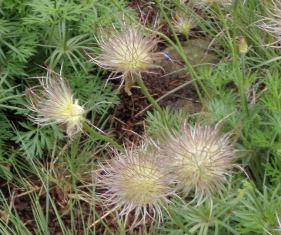A great plant for the month of May is the pasque flower. This plant would be a great addition to the wildflower mix on your acreage or even as a specimen plant in any landscape, including in towns and cities.
Pasque flower (Pulsatilla vulgaris) is a member of the Buttercup family of plants that includes anemones. For this reason, sometimes the pasque flower is listed with a scientific name of anemone vulgaris. The leaves and stems are covered with very fine hairs, giving the plant a fuzzy appearance. The leaves are deeply divided, similar to a fern. Pasque flowers will grow 9-12 inches tall. It blooms from April to May with yellow, white, dark violet, pale blue or red-violet colored flowers. The flowers have yellow, hairy centers, and turn into wispy, ornamental seed heads. These add interest to your garden because the seed heads are as intriguing as the flowers themselves.
Many great choices of pasque flower are available, to get the right color or combination of colors for your landscaping needs. The white flowering variety is known as 'Alba'. A dark red to violet colored flower variety known as 'Rubra'. Pulsatilla pratensis is another species. P. sylvestris is the species to choose if you prefer the yellow pasque flower.
Pasque flower is a fairly easy plant to care for. It can grown in very dry soils, but not wet soils, so be sure to plant it in an area with well-drained soils. It can grow in part to full sun. Pasque flower will reseed itself and fill in an area, especially in pastures. Pasque flower is poisonous to humans and livestock, so it can take over an area that is overgrazed as the livestock will not feed on it.
According to the University of Montana, Native Americans used the pasque flower to heal many illnesses, including rheumatism, neuralgia, headaches, inflammation, tuberculosis, and lung problems. As the plant is poisonous, they were very cautious with the amount given to a patient to not cause more harm than good. The University of Montana also states that pasque flower was used by Plains Indians to represent the cycle of life. The flower bud represented infancy, the flower bloom represented adolescents, and the seed head represented the "old man" with shaggy gray hair.
Pasque flower is a great plant to fill a space on your acreage or as a specimen plant in any landscape. The many color options will fit any color combination or provide a wide array of colors throughout your wildflower or prairie environment. They are fairly easy to care for when planted in a well-drained site, and they can keep reseeding themselves into a larger area. Consider the pasque flower for adding interest to your landscape while in flower and with the unique seed head.


